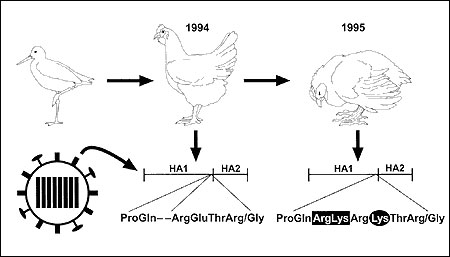Volume 4, Number 3—September 1998
THEME ISSUE
ICEID 1998
Zoonotic and Vector-borne Issues
Influenza: An Emerging Disease
Figure 1

Figure 1. Molecular changes associated with emergence of a highly pathogenic H5N2 influenza virus in chickens in Mexico. In 1994, a nonpathogenic H5N2 influenza virus in Mexican chickens was related to an H5N2 virus isolated from shorebirds (ruddy turnstones) in Delaware Bay, United States, in 1991. The 1994 H5N2 isolates from chickens replicated mainly in the respiratory tract, spread rapidly among chickens, and were not highly pathogenic. Over the next year the virus became highly pathogenic, and the hemagglutinin acquired an insert of two basic amino acids (Arg-Lys), possibly by classic recombination and a mutation of Glu to Lys at position 3 from the cleavage site of HA1/HA2.
Page created: December 14, 2010
Page updated: December 14, 2010
Page reviewed: December 14, 2010
The conclusions, findings, and opinions expressed by authors contributing to this journal do not necessarily reflect the official position of the U.S. Department of Health and Human Services, the Public Health Service, the Centers for Disease Control and Prevention, or the authors' affiliated institutions. Use of trade names is for identification only and does not imply endorsement by any of the groups named above.